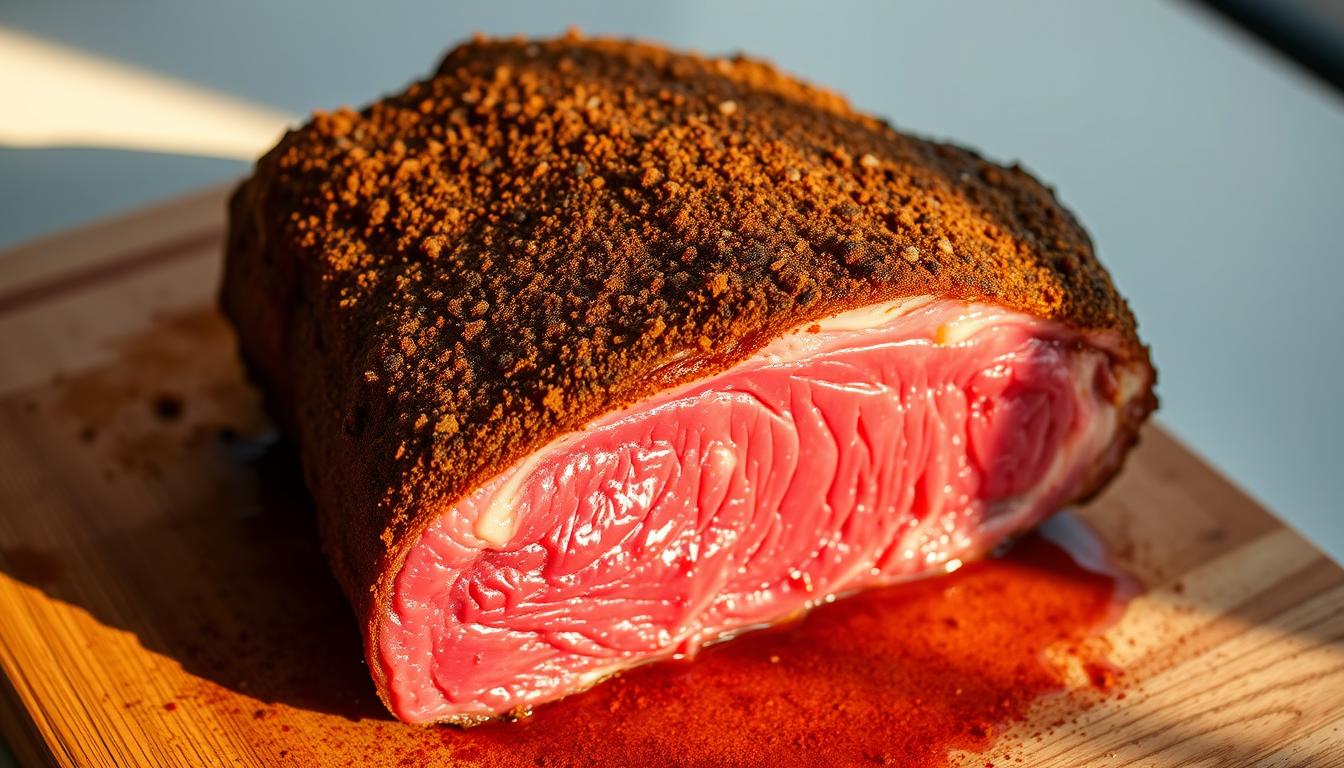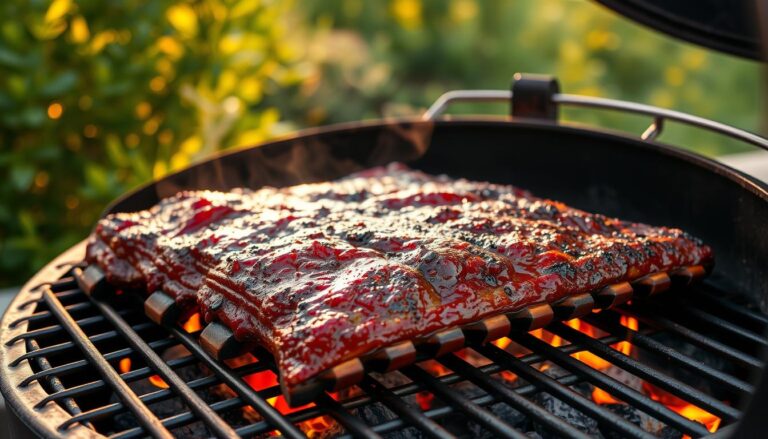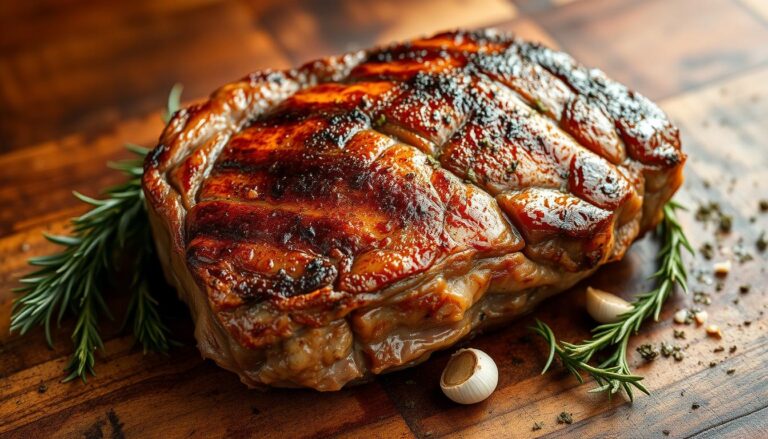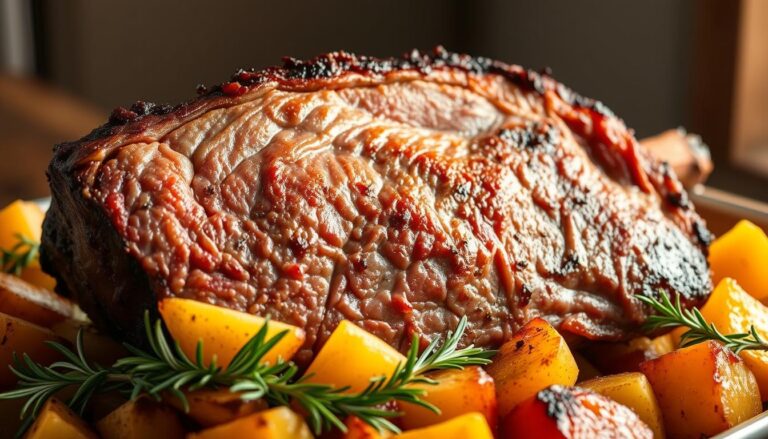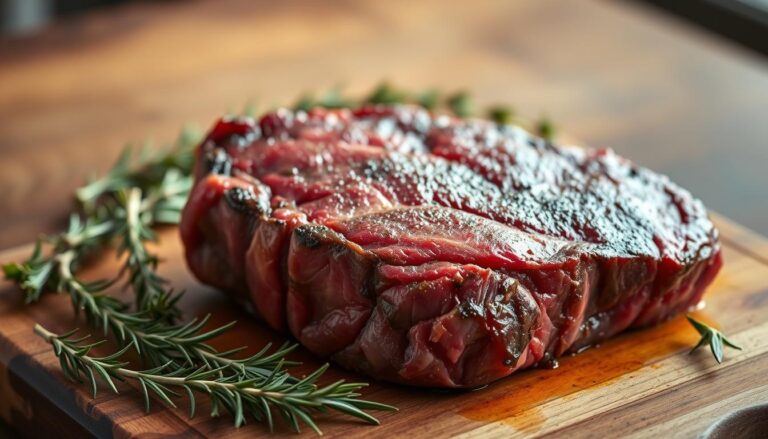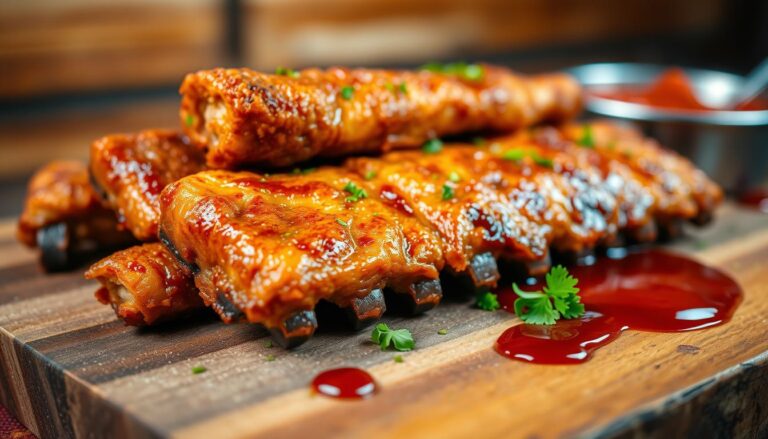Ultimate Beef Ribeye Roast Recipe – Juicy, Tender & Flavorful
Imagine the sizzle of a perfectly seared crust giving way to a tender, marbled interior. This beef ribeye roast recipe turns weeknight dinners into celebrations. It’s easy, with just a 5-ingredient dry rub, 30 minutes of prep, and 75 minutes in the oven.
Even if you’ve never roasted a prime cut before, this easy ribeye roast recipe delivers restaurant-quality results. Serve it to family, impress guests, or savor leftovers cold with a sprinkle of sea salt. It’s proof that greatness can come from simplicity.
Table of Contents
Understanding Ribeye Roast Cuts
Choosing the right ribeye roast starts with knowing your cuts. The ribeye roast comes from the rib section of the cow. It’s known for its rich marbling and tenderness. Whether you’re following a beef ribeye roast recipe or learning how to cook ribeye roast, understanding the cut’s anatomy ensures optimal flavor and texture.
What is Ribeye Roast?
Ribeye roast is part of the rib primal cut, sourced from ribs 6–12. Unlike ribeye steaks, the roast remains uncut, preserving its natural juices. Bone-in versions (prime rib) retain heat and moisture, while boneless roasts are easier to slice. Both types boast a fat cap that melts into the meat, enhancing tenderness. The USDA grades matter too: Prime offers the most marbling, Choice is budget-friendly, and Select is leaner.
Different Cuts of Ribeye
Key distinctions include:
- Bone-in vs. Boneless: Bone-in adds flavor but requires longer cooking. Boneless cuts weigh 4–6 lbs and serve 4–6 people.
- Lip-on vs. Lip-off: The “lip” refers to extra fat along the edge—lip-on versions are juicier.
- Size matters: A 4–6 lb roast serves 6–8 guests. Bone-in portions need ¾–1 lb per person; boneless uses ½–¾ lb.
When shopping, look for even fat distribution. Prime rib is a sub-primal cut, often reserved for holidays, while ribeye roast fits everyday meals. Always check the grade label to match your budget and taste preferences.
Understanding these details helps you pick the roast that fits your beef ribeye roast recipe and dining occasion.
Essential Ingredients for a Ribeye Roast
Classic seasonings include:
- Kosher salt (to draw out moisture)
- Coarsely ground black pepper
- Garlic powder (1 tsp)
- Dried sage (2 tsp)
- Dried thyme (2 tsp)
| Spice/Herb | Quantity | Purpose |
|---|---|---|
| Sage | 2 tsp | Enhances savory depth |
| Thyme | 2 tsp | Adds earthy notes |
| Rosemary | 2 tsp | Brings aromatic freshness |
| Parsley | 1 tsp | Brightens the flavor |
| Garlic | 5 cloves (minced) | Builds aromatic base |
For extra flavor, try onion powder or smoked paprika. Mix in ½ cup softened butter for a 6-lb roast. This adds richness. Coffee grounds in the rub give a smoky taste. But don’t overdo it—let the meat’s natural taste come through.
Preparing Your Ribeye Roast
Learning how to cook ribeye roast begins with the right prep. Follow these steps for a savory ribeye roast recipe that’s both flavorful and tender.
Thawing the Roast
For frozen ribeye:
- Refrigerator thawing takes 24 hours per 5 lbs. Place on a tray, cover, and let sit until fully thawed.
- Quick thaw: Submerge in cold water (changed every 30 minutes) for 2–3 hours.
Preparing the Meat for Cooking
Take the roast out of the fridge 1–2 hours before cooking. Let it reach room temperature. Dry it with paper towels for even browning.
Trim excess fat around the edges but keep the fat cap. This helps keep juices inside. Season with kosher salt, pepper, and garlic powder. Rub it firmly into the meat.
Place the roast on a rack in a roasting pan, fat side up. Heat your oven to 500°F. Make sure to use an oven-safe thermometer aimed at the roast’s center.
Cooking Methods for Beef Ribeye Roast
Learn to make a oven-roasted ribeye roast or grill for smoky taste. Follow these steps for tender, flavorful meat every time.
For the traditional ribeye roast recipe using an oven: Preheat to 450°F. Place the roast in a roasting pan fat-side up. Cook 15 minutes to form a crust. Then, reduce heat to 325°F and cook until it reaches 115°F for rare or 120–130°F for medium. Let it rest for 15–30 minutes before slicing.
- Use a meat thermometer to ensure accuracy—never guess by time alone.
- For reverse sear, start at 275°F until near desired temperature, then finish at 450°F for browning.
Grilling needs indirect heat. Arrange coals or gas burners to one side. Place the roast on the cooler side, with the lid closed. Aim for 225–250°F grill temp. Add wood chips like hickory for smoky flavor. Cook until it reaches the target internal temp, then rest as with oven method.
Pro tip: Let the meat rest to redistribute juices. Use a wire rack in the pan for even cooking. Always check USDA guidelines for safe minimum temps.
Cooking Temperature and Timing
Getting the right temperature and timing is key to a juicy and flavorful ribeye roast. Follow these tips to cook your how to cook ribeye roast just right.
Ideal Internal Temperatures
Use a meat thermometer to hit these targets:
- Rare: 120–125°F
- Medium-rare: 130–135°F
- Medium: 135–145°F
- Medium-well: 150–155°F
- Well-done: 160°F+
The USDA says to cook to 145°F for safety. But many chefs like it medium-rare (135°F) for juiciness. Remember, the meat will heat up another 5–10°F after you take it out of the oven.
“Cook 20 minutes per pound after browning.”
Cooking Time Estimates
Timing depends on:
- Oven accuracy
- Starting meat temperature
- Roast shape
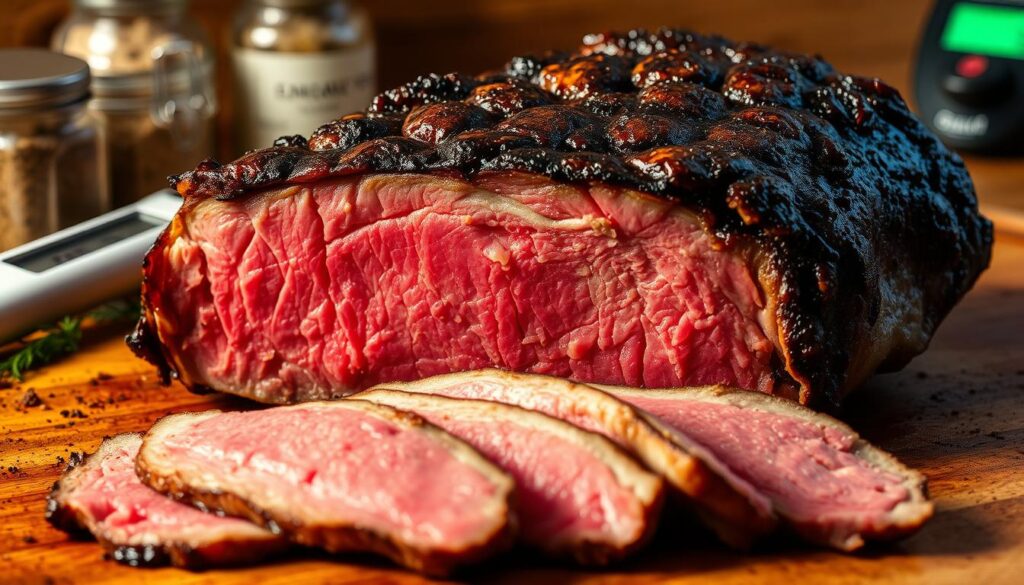
A 3-pound roast cooks for about 75 minutes. First, brown it at 500°F for 15 minutes. Then, cook it at 350°F for 60 minutes. Stop cooking when it’s 5–10°F below your target. For example, stop at 125°F if you want it medium-rare.
Follow these steps for the best beef ribeye roast recipe results. Adjust the timing by checking the thermometer often.
Resting and Serving Your Roast
Mastering the final steps of your delicious ribeye roast recipe ensures every bite stays tender. Proper resting and slicing makes all the difference in this beef ribeye roast recipe. Follow these steps to deliver a restaurant-quality meal.
Importance of Resting
Resting stops juices from escaping when sliced. After cooking, move the roast to a cutting board. Loosely cover with foil and let it rest for 30 minutes. This allows heat to redistribute and prevents dry meat.
Avoid tightly wrapping to keep the crust crisp.
Slicing the Ribeye Roast
Proper slicing maximizes flavor and texture. Follow these steps:
- Wait 30 minutes after cooking before slicing.
- Use a sharp knife and slice against the meat’s grain for tenderness.
- Cut ½-inch thick slices to retain moisture.
Serve on a platter with rosemary sprigs or microgreens. Drizzle pan juices or make a quick au jus with resting drippings. Leftover juices can be stored for up to 3 days in the fridge.
Flavor Enhancements and Sauces

Make your savory ribeye roast recipe even better with flavors that complement it. Choose sides and sauces that balance the meat’s richness. They should add texture and contrast.
Recommended Side Dishes
Choose dishes that highlight the meat without overpowering it:
- Sautéed broccolini with lemon zest and chili flakes
- Roasted carrots glazed with honey and thyme
- Arugula salad tossed with orange segments and shaved Parmesan
- Creamed spinach or roasted Brussels sprouts for earthy contrast
Sauces That Pair Perfectly
Let the roast’s juices guide your delicious ribeye roast recipe sauces:
- Au Jus Sauce: Simmer pan drippings with beef stock and bay leaves for 10 minutes.
- Horseradish Cream: Whisk sour cream with 1 tbsp prepared horseradish and a squeeze of lime.
- Red Wine Reduction: Deglaze the pan with Cabernet Sauvignon, reduce by half, and season with salt.
Try chimichurri (parsley-cilantro pesto) or balsamic fig compote for a twist. Choose sauces that match the roast’s seasoning. Smoky rubs go well with tangy sauces like apple cider vinegar or mustard glazes.
Storing Leftover Ribeye Roast
Leftover ribeye roast stays fresh longer with smart storage. Follow these steps to keep meat safe and flavorful for future meals.
Refrigeration Tips
Store leftovers in an airtight container within 2 hours of cooking. Divide large portions into freezer-friendly bags for easy use later. Keep refrigerated leftovers for up to 4 days or freeze for 2-3 months. Slicing meat before freezing makes it ready-to use in quick meals like tacos or the slow cooker ribeye roast recipe.
Reheating Options
- Oven Method: Heat oven to 325°F. Cover meat with foil and warm for 15–20 minutes until heated through.
- Microwave: Heat 30-second intervals on 50% power, stirring occasionally. Avoid overcooking to prevent drying.
- Stovetop: Simmer slices in beef broth for 5–7 minutes to retain moisture.
For a fresh twist, repurpose leftovers in the easy ribeye roast recipe for dishes like:
- Cold cuts: Arrange sliced meat on platters with Dijon mustard or sriracha mayo.
- Slow cooker meals: Shred leftovers and add to a slow cooker with broth for pulled beef hash.
- Quick meals: Dice into stir-fries or top salads for added protein.
Freeze unused portions in labeled bags. Label with dates to track freshness. Thaw frozen meat in the fridge overnight before reheating.
Tips for Perfect Ribeye Every Time
Mastering the best ribeye roast recipe means avoiding common mistakes and using proven methods. These tips ensure every bite is tender and flavorful.
Common Mistakes to Avoid
Always use an oven-safe thermometer to get the exact temperature. Cooking below 145°F is unsafe, and too much in the pan stops browning. Don’t open the oven too often to keep the temperature steady.
Let the roast rest for 10-15 minutes before cutting. This helps keep the juices inside. Choose a 3-5 pound roast for 4-6 people.
Pro Chef Secrets for Juiciness
Start by dry-brining the roast with kosher salt 24 hours before cooking. Use a cast iron skillet to create a rich crust. Try the reverse sear method: cook at 250°F first, then sear at high heat.
For roasts over 3 pounds, cook at 350°F for 20 minutes per pound. Use a thermometer to aim for 135°F for medium-rare. USDA Prime or American Wagyu beef is best for tenderness and flavor.
Pair your roast with Cabernet Sauvignon for a classic taste. With practice, your kitchen will become a steakhouse. The right tools and techniques guarantee a perfect roast every time.

